Clucas Surname Ancestry ResultsOur indexes 1000-1999 include entries for the spelling 'clucas'. In the period you have requested, we have the following 45 records (displaying 31 to 40): Single Surname Subscription | | | Buying all 45 results of this search individually would cost £232.00. But you can have free access to all 45 records for a year, to view, to save and print, for £100. Save £132.00. More... |
These sample scans are from the original record. You will get scans of the full pages or articles where the surname you searched for has been found. Your web browser may prevent the sample windows from opening; in this case please change your browser settings to allow pop-up windows from this site. Freemasons in Ormskirk chapter
(1938)
List of members of the Ancient and Accepted Rite for England, Wales, the Dominions and Dependencies of the British Crown, January 1938. An asterisk before a name indicates a P. M. W. S. of the Chapter; the number 30 indicates a Grand Elected Knight, K. H., 30th Degree; 31, Grand Inspector Inquisitor Commander, 31st Degree; 32, Sublime Prince of the Royal Secret, 32nd Degree.CLUCAS. Cost: £4.00.  | Sample scan, click to enlarge
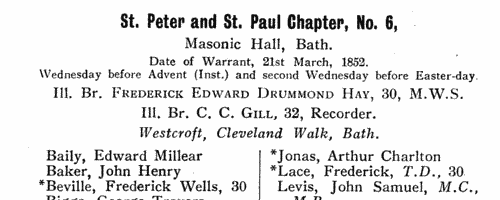
| Imperial Service Medal
(1941)
The Central Chancery of the Orders of Knighthood at St James's Palace announced these awards by king George VI of the Imperial Service Medal to members of the Home Civil Service. The names are arranged alphabetically by surname (in capitals) and christian names, with office or rank in the service.CLUCAS. Cost: £6.00.  | Sample scan, click to enlarge
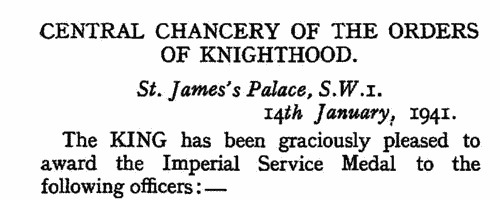
| Boys entering King William's College, Isle of Man
(1944)
King William's College at Castletown on the Isle of Man was established in 1830. By 1928 about 290 boys were being educated there, 'of whom three-fourths are boarders, and the remainders sons of natives or residents in the Island.' Boys entered the junior school about 9 or 10 years of age, the upper school about 13; boys over 13 were not admitted 'unless attainments and character are specially satisfactory'. There were 'several nominations for the sons of clergy and others'.
Editions of the college register were published in 1905 and 1927. When this third edition was prepared, in 1956, it was felt unnecessary to repeat the whole of the register from 1830 onwards, a new starting point being chosen as September 1886, when the reverend Frank Bridgman Walters took office as principal.
The items are arranged alphabetically within term of entry; surname is given first, in bold, and then full christian names; then, to the right, in bold, precise date of birth, school house, and month of leaving the school. The abbreviations for houses are: C, Colbourne; D, Dickson; H, Hunt; Ha, Hangoside; J, Junior House; R, Raglan; S, School House (formerly Principal's); T, town houses occupied by masters who took in boys prior to September 1889; Tr, Trafford's; W, Walters.
Each entry then gives the boy's father's name (surname and initials) and address at that time; school honours (such as Prae., praepositor, XI, school cricket team); a career synopsis; and finally, in italics, to the right, year of death, or present address in 1956, if known.CLUCAS. Cost: £4.00.  | Sample scan, click to enlarge
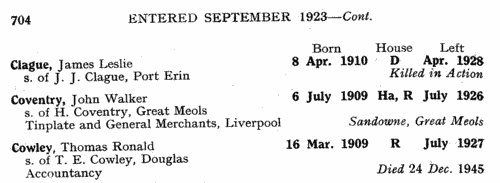
| Boys entering King William's College, Isle of Man
(1946)
King William's College at Castletown on the Isle of Man was established in 1830. By 1928 about 290 boys were being educated there, 'of whom three-fourths are boarders, and the remainders sons of natives or residents in the Island.' Boys entered the junior school about 9 or 10 years of age, the upper school about 13; boys over 13 were not admitted 'unless attainments and character are specially satisfactory'. There were 'several nominations for the sons of clergy and others'.
Editions of the college register were published in 1905 and 1927. When this third edition was prepared, in 1956, it was felt unnecessary to repeat the whole of the register from 1830 onwards, a new starting point being chosen as September 1886, when the reverend Frank Bridgman Walters took office as principal.
The items are arranged alphabetically within term of entry; surname is given first, in bold, and then full christian names; then, to the right, in bold, precise date of birth, school house, and month of leaving the school. The abbreviations for houses are: C, Colbourne; D, Dickson; H, Hunt; Ha, Hangoside; J, Junior House; R, Raglan; S, School House (formerly Principal's); T, town houses occupied by masters who took in boys prior to September 1889; Tr, Trafford's; W, Walters.
Each entry then gives the boy's father's name (surname and initials) and address at that time; school honours (such as Prae., praepositor, XI, school cricket team); a career synopsis; and finally, in italics, to the right, year of death, or present address in 1956, if known.CLUCAS. Cost: £4.00.  | Sample scan, click to enlarge
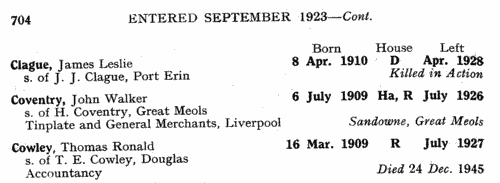
| Royal Corps of Signals: Regular Army Emergency Commissions: 2nd Lieutenants
(1946)
The Army List for October 1946 lists the 4300 officers of the Royal Corps of Signals by rank and seniority (i.e., the date from which their particular rank was to be reckoned). The names are given as surnames and initials. The many temporary commissions bestowing brevet or higher rank are listed in italics, with date, together with any decorations. In front of the surnames three abbreviations may occur: a bold R, meaning released to unemployment; a crossed-swords symbol for meritorious war service; and a pilcrow, for service without pay and allowances. There are separate sections for retired officers temporarily re-employed, the Territorial Army, and Regular Army Emergency Commissions (including African Colonial, Caribbean, Egypt and Palestine forces), Supplementary Reserve Category B.
CLUCAS. Cost: £4.00.  | Sample scan, click to enlarge
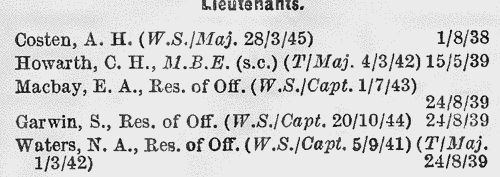
| Graduates of the Institution of Mechanical Engineers (G. I. Mech. E.)
(1947)
The Institution of Mechanical Engineers, founded in 1847, was incorporated by royal charter in 1930. The list of members of 1 March 1947 gives the names (surname first) and addresses of the seven classes of member - Honorary Members (Hon. M. I. Mech. E.); Members (M. I. Mech. E.); Associate Members (A. M. I. Mech. E.); Companions (C. I. Mech. E.); Associates (A. I. Mech. E.); Graduates (G. I. Mech. E.); and Students (S. I. Mech. E.). The year of attaining qualification is given in the left-hand margin; in the higher grades the years of achieving the lower grades are also given, bracketed together. The crossed swords symbol indicates naval or military service during the Great War of 1914-1918; an italic b shows a member of the Benevolent Fund. (p) after a Graduate's or a Student's name indicates one who had passed the whole of the A. M. Examination or its recognized equivalent.CLUCAS. Cost: £4.00.  | Sample scan, click to enlarge
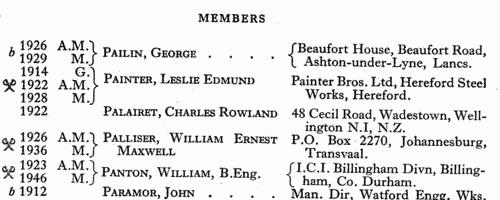
| British Dentists
(1950)
The Dentists Register is the official register of British dental practitioners. For each dentist the original certificate number is given; name (surname first, in bold; in the case of married women, maiden name is also usually given); address (in italics); date of registration; and the qualification entitling registration, with any additional qualifications, with year and place of qualification. Many of the older dentists, already practising by 1921, were qualified by virtue of the Dentists Act of that year.CLUCAS. Cost: £4.00.  | Sample scan, click to enlarge

| Ex-Apprentices of British Thomson-Houston Company
(1951)
In 1938 the British Thomson-Houson Co Ltd of Rugby first published a 'record of those who embarked upon careers in the Engineering Industry by way of the British Thomson-Houston Company's Training Scheme': this enlarged edition was issued in September 1951, based on data verified up to December 1948, with subsequent corrections up to the time of printing. The company had been training apprentices since 1899.
The names of the deceased were printed in italics: the most vestigial entries in the volume simply give full name, and the years of apprenticeship; but most entries are much more comprehensive. The symbol 'w' indicates killed by enemy action.
In the first column full name is given in bold, surname first (in capitals), and then any title, decorations, academic qualifications in italics. Beneath that is current address (as of 1951); and then (to the left) year of birth, and (to the right) nature of course followed and years (e. g. 30-32 for 1930 to 1932) of commencement and completion. The abbreviations for the courses are: C, Craft Apprentice; Ch, Chemist Apprentice; Cl, Clerical Apprentice; D, Drawing Office Apprentice; E, Engineering Student Apprentice (Engineering Apprentice up to 1947); G, Graduate Apprentice (Student Apprentice up to 1947); (s), Special Course; T, Testers' Course; V, Vacation Student; W. O., Works Office Apprentice.
The second column gives particulars of academic training, war service, and miscellaneous information.
The third column gives positions held in the past (printed in italics) and present position (as of 1951) where known.CLUCAS. Cost: £4.00.  | Sample scan, click to enlarge
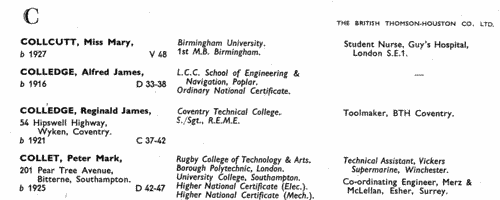
| Electrical Engineers
(1952)
The Institution of Electrical Engineers was founded in 1871, and incorporated by royal charter in 1921. There were seven grades of member (honorary member, member, associate member, companion, associate, graduate, and student); this is the list of the 19,699 members of the latter three grades as of 1 July 1952. Most of the members were from Britain, but there were Oversea Branches for Calcutta, Ceylon and Ireland, and Oversea Committees in Australia, India, Malaya and Singapore, New Zealand and South Africa. The associates (A), graduates (G) and students (S) are listed together in a single alphabetical list by surname and christian name(s), with year of entering the grade. Some of the members also belonged to specialized sections of the institution, and these are indicated at the right by the letters M (measurements), R (radio), S (supply) and U (utilization).CLUCAS. Cost: £4.00.  | Sample scan, click to enlarge
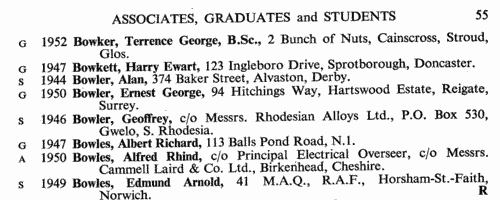
| British Civil Servants
(1953)
The British Imperial Calendar lists civil servants in Britain, arranged according to the organizational structure of the state, and shows their qualifications and salaries. CLUCAS. Cost: £4.00.  | Sample scan, click to enlarge
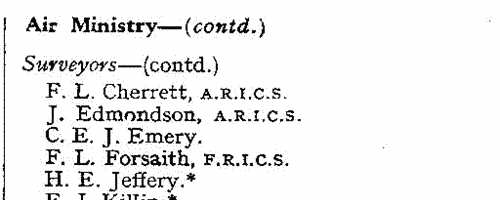
|
Research your ancestry, family history, genealogy and one-name study by direct access to original records and archives indexed by surname.
|












